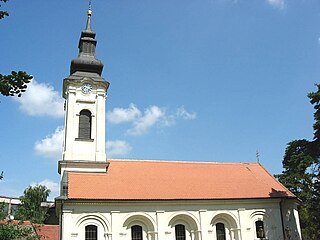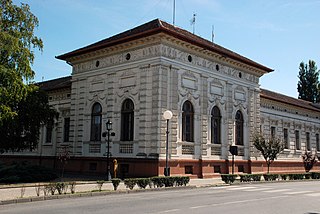
Vojvodina, officially the Autonomous Province of Vojvodina, is an autonomous province that occupies the northernmost part of Serbia, located in Central Europe. It lies within the Pannonian Basin, bordered to the south by the national capital Belgrade and the Sava and Danube Rivers. The administrative center, Novi Sad, is the second-largest city in Serbia.

Banat is a geographical and historical region that straddles Central and Eastern Europe. It is currently divided among three countries: the eastern part lies in western Romania ; the western part of Banat is in northeastern Serbia ; and a small northern part lies within southeastern Hungary.

Bačka or Bácska is a geographical and historical area within the Pannonian Plain bordered by the river Danube to the west and south, and by the river Tisza to the east. It is divided between Serbia and Hungary. Most of the area is located within the Vojvodina region in Serbia and Novi Sad, the capital of Vojvodina, lies on the border between Bačka and Syrmia. The smaller northern part of the geographical area is located within Bács-Kiskun County in Hungary.

Slavo-Serbia or Slaveno-Serbia was a territory of Imperial Russia from 1753 to 1764. It was located to the south of the Donets River, between the Bakhmutka River and Luhan River. This area today is located within present-day Luhansk Oblast and Donetsk Oblast of Ukraine. The administrative centre of Slavo-Serbia was Bakhmut.

The Pannonian Basin, or Carpathian Basin, is a large sedimentary basin situated in southeast Central Europe. The geomorphological term Pannonian Plain is more widely used for roughly the same region though with a somewhat different sense, with only the lowlands, the plain that remained when the Pliocene Epoch Pannonian Sea dried out.

Novi Kneževac is a town and municipality located in the North Banat District of the autonomous province of Vojvodina, Serbia. The town has a population of 6,960, while the Novi Kneževac municipality has 11,269 inhabitants according to.

Alibunar is a town and municipality located in the South Banat District of the autonomous province of Vojvodina, Serbia. Alibunar town and Alibunar municipality have a population of 2,883 and 19,780 respectively.

Srbobran is a town and municipality located in the South Bačka District of the autonomous province of Vojvodina, Serbia. The town is located on the north bank of the Danube-Tisa-Danube canal. The town has a population of 12,009, and the municipality of 16,317.
Vojvodina is an autonomous province located in northern Serbia. It consists of the Pannonian Plain in the south, and the Danube and Sava rivers in the north.

The Serbs of Vojvodina are the largest ethnic group in this northern province of Serbia. For centuries, Vojvodina was ruled by several European powers, but Vojvodina Serbs never assimilated into cultures of those countries. Thus, they have consistently been a recognized indigenous ethnic minority with its own culture, language and religion. According to the 2022 census, there were 1,190,785 Serbs in Vojvodina or 68.43% of the population of the province.

The District of Potisje was an administrative territorial entity of the Habsburg monarchy. It was formed in 1751 with headquarters in Stari Bečej, and existed for almost one century.

Nova Pazova is a settlement in Serbia. It is situated in the Stara Pazova municipality, in the region of Syrmia, in the autonomous province of Vojvodina. The settlement's population is currently 17,105.

Peter Tekeli (1720–1792) was a Russian general-in-chief of Serb origin. He achieved the highest rank among the Serbs who served in the Imperial Russian Army. He was born in a noble family of military tradition, whose men were officers of the Austrian army in the Military Frontier. Prior to his emigration to Russia in 1748, he fought as a young officer in the War of the Austrian Succession. Characterized by both courage and military cunning, he made a splendid career in Russia. He participated in the Seven Years' War, the first Russo-Turkish War (1768–1774), and the second Russo-Turkish War (1787–1792). Under his command, Zaporozhian Cossacks were disbanded and subjugated to the Imperial authority in 1775, without spilling a single drop of blood, for which he received the Order of St. Alexander Nevsky from Empress Catherine the Great. He retired in 1790, and died two years later in his mansion at Novomirgorod.

Vasilije "Vasa" Živković (1819–1891) was a Serbian poet and Orthodox priest. He is highly regarded in Serbian culture for his role in collecting verses from oral traditions of his people. His literary opus sustained only half of his poems to be printed since he was prone to self-criticism. His contemporaries were poets Jovan Ilić, father of Vojislav Ilić, Stevan Vladislav Kačanski, and many others.
Avram Miletić was a merchant and writer of epic folk songs who is best known for writing the earliest collection of urban lyric poetry in Serbian between 1778 and 1781.
Aleksije Vezilić was a Serbian lyric poet who introduced the German version of the Enlightenment to the Serbs.

Jovan Šević or Ivan Šević was an 18th-century military officer of Serb origin. He reached the rank of lieutenant colonel in the Serb militia forces in the Pomorišje region, then in the Military Frontier of the Habsburg monarchy. When it became obvious that privileges granted to Serb militiamen would be reduced or completely revoked after Pomorišje and Potisje lost their frontier status, Šević left Habsburg military service in 1750 and moved to Russia. At the end of 1752, he led the second wave of colonists who migrated from Pomorišje, Potisje and Slavonia to the Russian Empire where they settled the newly established administrative region of Slavo-Serbia at the beginning of 1753. To enable him to recruit more of his fellow officers, Šević was promoted to the rank of General by the Russian Empress, Elizabeth. He commanded a Serb Hussar Regiment consisting of the colonists he brought to Russia. After Šević's death, Slavo-Serbia was disestablished, and many of his descendants became notable military officers in the Russian Imperial Army. Over time, all the Serb colonists became assimilated. Miloš Crnjanski described the migration led by Šević in his most notable work, the novel Migrations.

There is a community of Serbs in Russia, also known as Russian Serbs, which includes Russian citizens of ethnic Serb descent or Serbian-born people residing in the country.
Simeon Piščević was a Serbian memoirist and imperial Russian general.
Jovan Samuilović Horvat de Kurtič, also referred to as Ivan Horvat, was a Russian general of Serbian origin who founded New Serbia in the modern Kirovohrad Oblast.




















